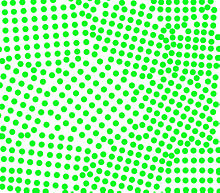
Back Korrelgrens AF حد حبيبي Arabic Frontera de gra Catalan سنووری دەنکۆڵە CKB Korngrenze German Όριο κόκκου Greek Borde de grano Spanish مرز دانه FA Joint de grains French Granica kristalnog zrna Croatian


In materials science, a grain boundary is the interface between two grains, or crystallites, in a polycrystalline material. Grain boundaries are two-dimensional defects in the crystal structure, and tend to decrease the electrical and thermal conductivity of the material. Most grain boundaries are preferred sites for the onset of corrosion[1] and for the precipitation of new phases from the solid. They are also important to many of the mechanisms of creep.[2] On the other hand, grain boundaries disrupt the motion of dislocations through a material, so reducing crystallite size is a common way to improve mechanical strength, as described by the Hall–Petch relationship.
- ^ Lehockey, E.M.; Palumbo, G.; Lin, P.; Brennenstuhl, A.M. (May 1997). "On the relationship between grain boundary character distribution and intergranular corrosion". Scripta Materialia. 36 (10): 1211–1218. doi:10.1016/S1359-6462(97)00018-3.
- ^ Raj, R.; Ashby, M. F. (April 1971). "On grain boundary sliding and diffusional creep". Metallurgical Transactions. 2 (4): 1113–1127. Bibcode:1971MT......2.1113R. doi:10.1007/BF02664244.